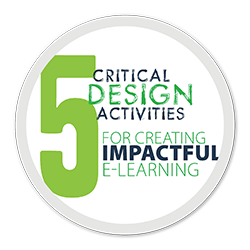Blog
Upcoming ASTD Webinar With Ethan Edwards!
Ethan Edwards held a webinar this week on 10 Ways to Ruin Your e-Learning—a How-to-Guide in Reverse—highlighting and providing advice and tips to ...


Helping You Combat the 10 Ways to Ruin e-Learning
By Allen Interactions | June 28, 2013 | Custom Learning | 0 Comments
9. Use the standard “C-Shell” template for screen layout of your lessons.
8. Show a person talking to introduce all textual statements.
7. Score and record every action the user takes.
6. Limit your interactions severely to fit the LMS data standards set by the IT Department.
5. Open the lesson with formal learning objectives.
4. Write e-learning content to be an exhaustive treatment of the field.
3. Dictate learner’s progress and sequence through the lesson.
2. Record verbatim the words that are on the screen.
1. Create e-learning in PowerPoint and import into an authoring tool.
 Because of the feedback we’ve received from this webinar, we’re offering our blog community several complimentary design reviews with the hopes of providing you with suggestions and ideas to improve your e-learning designs and combat these 10 Ways to Ruin Your e-Learning.
Because of the feedback we’ve received from this webinar, we’re offering our blog community several complimentary design reviews with the hopes of providing you with suggestions and ideas to improve your e-learning designs and combat these 10 Ways to Ruin Your e-Learning..png?width=135&height=135&name=ai-symbol-green%20(3).png)
About the Author: Allen Interactions
Comments
Would you like to leave a comment?
Related Blog Posts

By: Allen Interactions | Jul, 2013
Category: Custom Learning

Blog
10 Ways to Ruin Your e-Learning by Following Commonly-Held Practices
Ethan Edwards held a webinar this week on 10 Ways to Ruin Your e-Learning—a How-to-Guide in Reverse—highlighting and providing advice and tips to ...
By: Allen Interactions | Jan, 2013
Category: Custom Learning

Blog
3 Reasons To Attend ATD's E-Learning Instructional Design Training
Ethan Edwards held a webinar this week on 10 Ways to Ruin Your e-Learning—a How-to-Guide in Reverse—highlighting and providing advice and tips to ...
By: Allen Interactions | Jul, 2015
Category: Custom Learning


